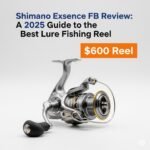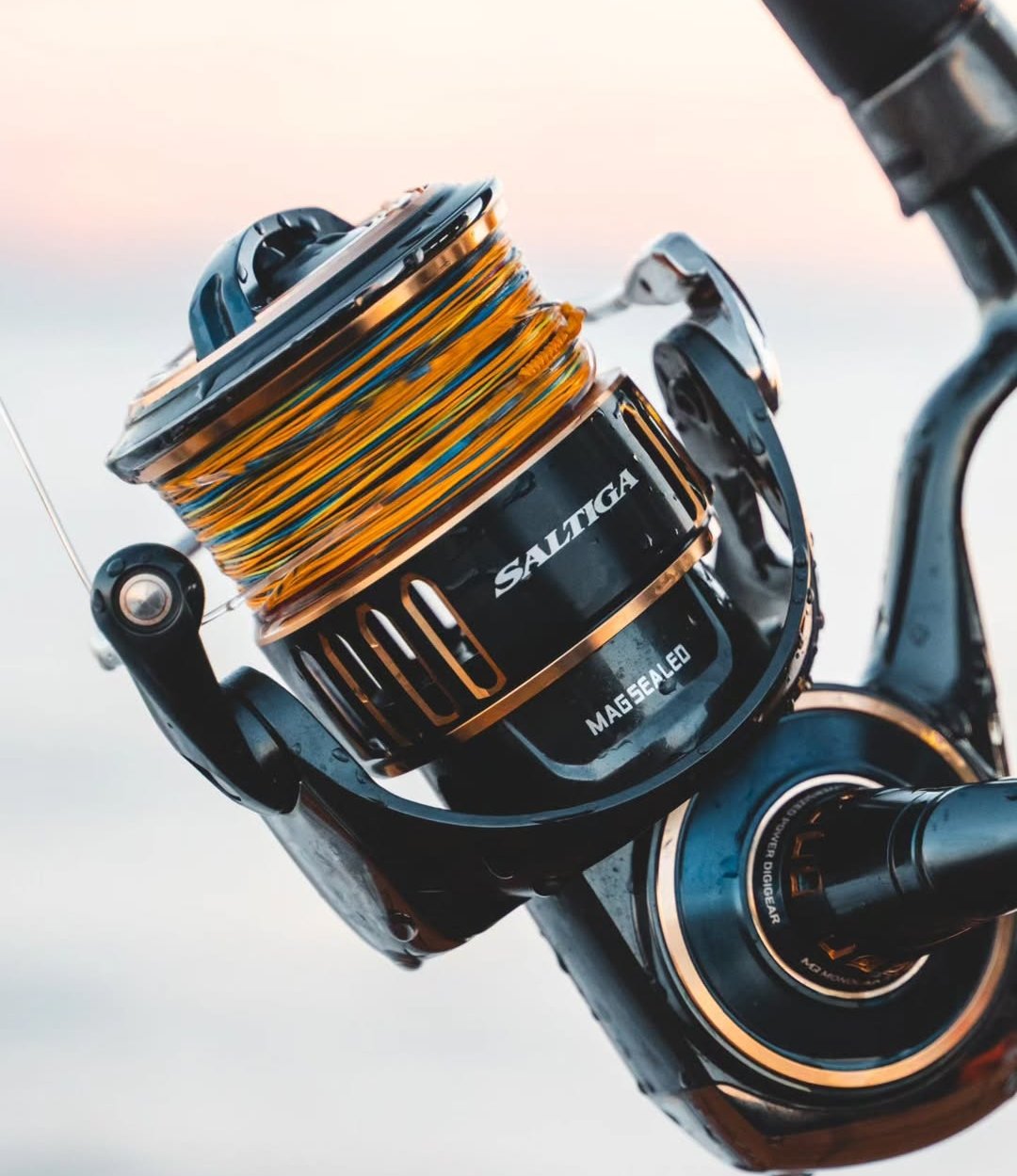
Last season, I watched a kayaker pull 12 keeper Dungeness crabs from a single pot while nearby boat anglers struggled to find two—proving that kayaks aren’t just competitive for crabbing, they’re often superior. 🦀
Traditional crabbing methods are gear-heavy and location-limited, forcing anglers to invest thousands in boats or settle for crowded shore spots. But kayak crab fishing changes everything. The stealth advantage of a paddle-powered vessel, combined with access to shallow, productive waters that boats can’t reach, creates opportunities that most crabbers never discover.
After fifteen years of targeting both Pacific Dungeness and Atlantic blue crabs from my kayak, I’ve learned that success isn’t about expensive gear or secret spots—it’s about understanding how these crustaceans behave and positioning yourself where they feed. Whether you’re working the rocky bottoms of Puget Sound or the grass flats of Chesapeake Bay, the principles remain consistent.
This guide covers everything from species-specific techniques for Dungeness and blue crabs to advanced strategies that consistently produce limits. You’ll learn the gear setups that work, the timing secrets that separate successful crabbers from the frustrated masses, and the safety protocols that keep you productive season after season.
Key Takeaways

- Kayaks provide superior access to shallow, productive crab habitats that boats can’t reach safely
- Species-specific techniques are essential—Dungeness crabs require different gear and timing than blue crabs
- Tidal timing matters more than location—incoming tides trigger feeding behavior in both species
- Proper trap deployment from a kayak requires modified techniques for safety and efficiency
- Regulatory compliance varies significantly by region and requires careful attention to licensing and harvest rules
Kayak Crab Fishing Basics: Why Kayaks Are Perfect for Crabbing
The stealth advantage of kayak crab fishing cannot be overstated. While motorized boats announce their presence with engine noise and prop wash, kayaks slip silently over crab habitat without disturbing the bottom or spooking wary crustaceans. This quiet approach allows you to work areas where crabs remain active and feeding, rather than hiding in their burrows.
Access to productive shallow waters represents the biggest advantage of kayak crabbing. Most crabs are caught within a 10-minute paddle from the beach, in water depths of 8-25 feet where larger boats fear to venture. These shallow zones often hold the highest concentrations of feeding crabs, particularly during tidal changes when crustaceans move up from deeper water to hunt.
The cost-effectiveness compared to boat crabbing is remarkable. While boat owners invest $30,000-$100,000+ in vessels, trailers, and maintenance, kayak crabbers can get started with a quality fishing kayak for under $2,000. Fuel costs disappear, launch fees become minimal, and storage requirements shrink dramatically.
Equipment portability transforms your crabbing opportunities. Everything needed for a successful trip—traps, lines, bait, and safety gear—fits easily in a kayak’s storage compartments. This mobility means you can quickly relocate when conditions change or explore new areas without the logistics nightmare of moving a boat.
The storage benefits extend beyond the water. Crab traps, lines, and gear store compactly in garages or sheds, while boat crabbers struggle with marina fees and winter storage costs. When choosing the right fishing kayak for crabbing, prioritize models with ample storage and stable platforms for handling traps safely.
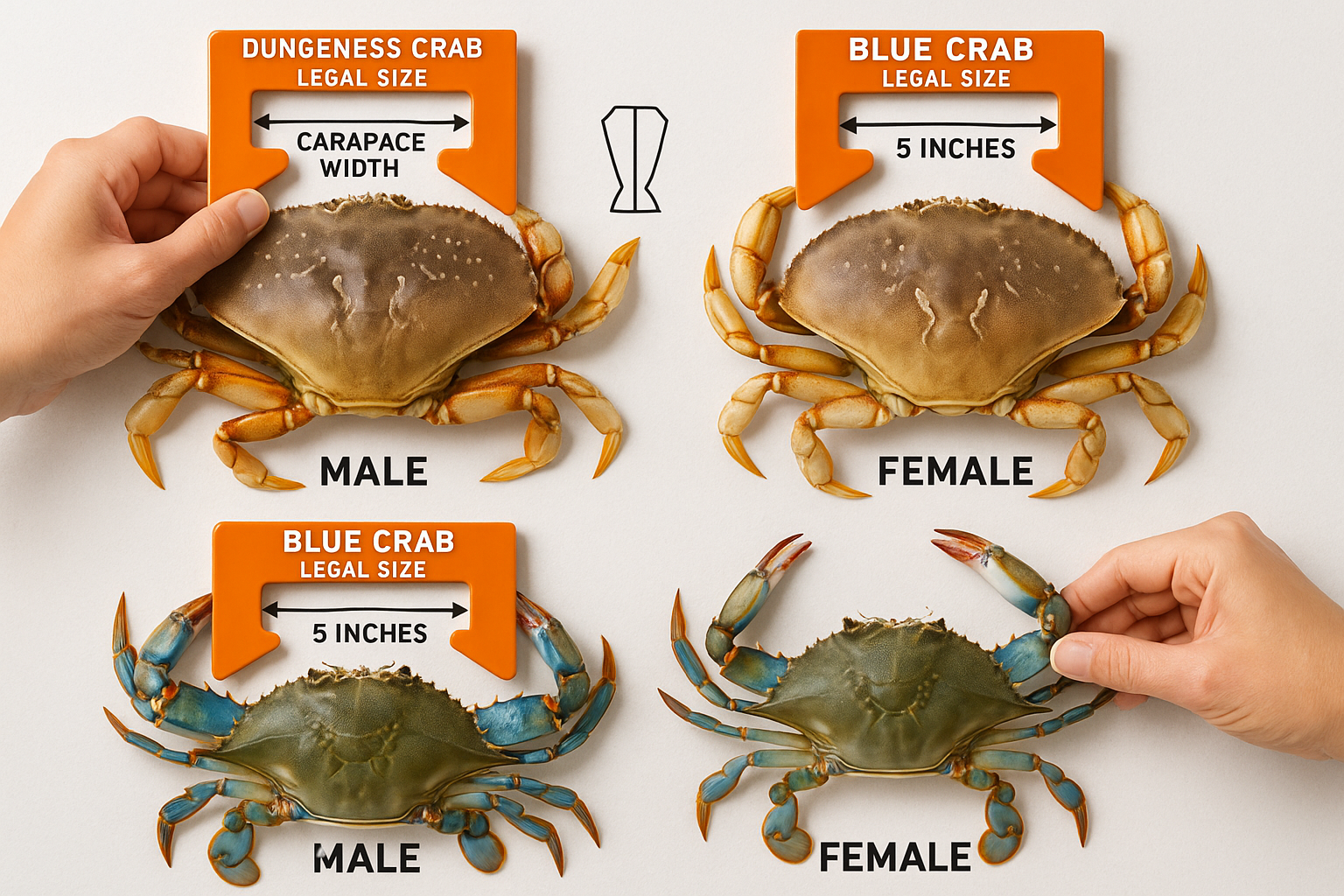
Essential Gear for Kayak Crab Fishing: Complete Setup Guide
Trap selection varies dramatically between target species and fishing styles. For Dungeness crab, the Danielson FTC Crab Trap excels in rocky Pacific waters, while the Joy Fish Maryland Blue Crab Pot Trap dominates Atlantic grass flats. The key difference lies in construction—Dungeness traps need heavier gauge wire to withstand rocky bottoms, while blue crab traps prioritize easy entry and retention.
For active crabbing, a hoop net specifically designed for crabbing, with a diameter of around 30 inches, provides immediate feedback and allows you to work multiple spots quickly. These nets work best in water 15 feet or shallower, where you can see bottom structure and actively work the gear.
Line and buoy systems require careful consideration for kayak deployment. Try a rope that is one-and-a-half times longer than the water depth to account for tidal changes and current drift. Polypropylene line floats naturally and resists abrasion, while nylon stretches under load but sinks, creating different handling characteristics.
Make sure to properly weigh down each line with a weight so it is not floating and can become stuck in boat propellers. This safety consideration protects other mariners while keeping your gear fishing effectively. Use 2-4 ounce weights attached 3 feet up from the trap to ensure lines sink properly.
Safety equipment extends beyond standard kayak gear when crabbing. Heavy-duty gloves protect when handling live crabs and minimize your risk of getting pinched. Kevlar-reinforced gloves provide the best protection while maintaining dexterity for measuring and handling.
A crab gauge ensures legal compliance—different species have different minimum sizes, and violations carry serious penalties. Digital calipers provide the most accurate measurements, while traditional gauges work faster when processing multiple crabs.
Kayak-specific modifications enhance crabbing efficiency. Rod holders repurposed as trap line holders keep deployed gear organized. Milk crates secured to deck rigging provide secure crab storage with adequate ventilation. Advanced kayak setups can include GPS fish finders for marking productive spots and tracking trap locations.
🦀 Kayak Crab Fishing Gear Calculator
🎯 Your Customized Gear Setup
📋 Essential Gear Checklist:
Crab Species Guide: Dungeness vs Blue Crab Techniques
Dungeness Crab (Pacific Coast)
Habitat preferences for Dungeness crabs center on sandy and muddy bottoms with scattered rocks or shell debris. These crustaceans prefer water temperatures between 50-60°F and typically inhabit depths from 10-300 feet, though kayak crabbers focus on the 15-50 foot range where access remains practical.
Seasonal patterns follow predictable cycles along the Pacific Coast. The California season usually starts in early July and runs through Labor Day, Thursday through Monday, while Washington and Oregon seasons extend longer, often from December through September with summer closures to protect molting crabs.
For optimal gear, use a hoop net specifically designed for crabbing, with a diameter of around 30 inches for active fishing. The larger diameter increases catch efficiency, while the heavy-gauge construction withstands the rocky Pacific bottom. For passive fishing, invest in rectangular wire traps with escape holes sized to release sublegal crabs automatically.
Size and sex regulations vary significantly by state. California requires male Dungeness crabs to measure 5.75 inches across the carapace, while Oregon and Washington set the minimum at 6.25 inches. Only males may be harvested—females must be released immediately regardless of size. The distinctive narrow, triangular abdominal flap on males versus the broad, rounded flap on females makes identification straightforward.
Blue Crab (Atlantic Coast)
Different trap requirements reflect blue crab behavior patterns. These aggressive feeders respond well to chicken necks and fish heads, entering traps more readily than Dungeness crabs. Pyramid-style traps with four entry funnels maximize catch rates, while collapsible models store efficiently in kayak compartments.
Seasonal migration patterns drive timing strategies for blue crab success. Spring warming triggers movement from deep winter refuges to shallow feeding areas. Peak activity occurs during summer months when water temperatures reach 70-80°F, while fall cooling concentrates crabs in deeper channels before winter dormancy.
Handling and measurement differences require adjusted techniques. Blue crabs measure point-to-point across the carapace, with most states requiring 5-inch minimums for males and seasonal restrictions on females. The species’ aggressive nature demands extra caution—their powerful claws can inflict serious injury even through standard gloves.
Regional Variations and Local Species
West Coast alternatives include red rock crabs, which occupy similar habitat to Dungeness but require different handling. These smaller crabs cluster in rocky areas and respond well to fresh fish baits. Their smaller size means higher bag limits but also requires careful sorting to separate species.
East Coast diversity extends beyond blue crabs to include stone crabs in southern waters and rock crabs in northern regions. Each species requires specific gear and techniques, making regional knowledge essential for consistent success.
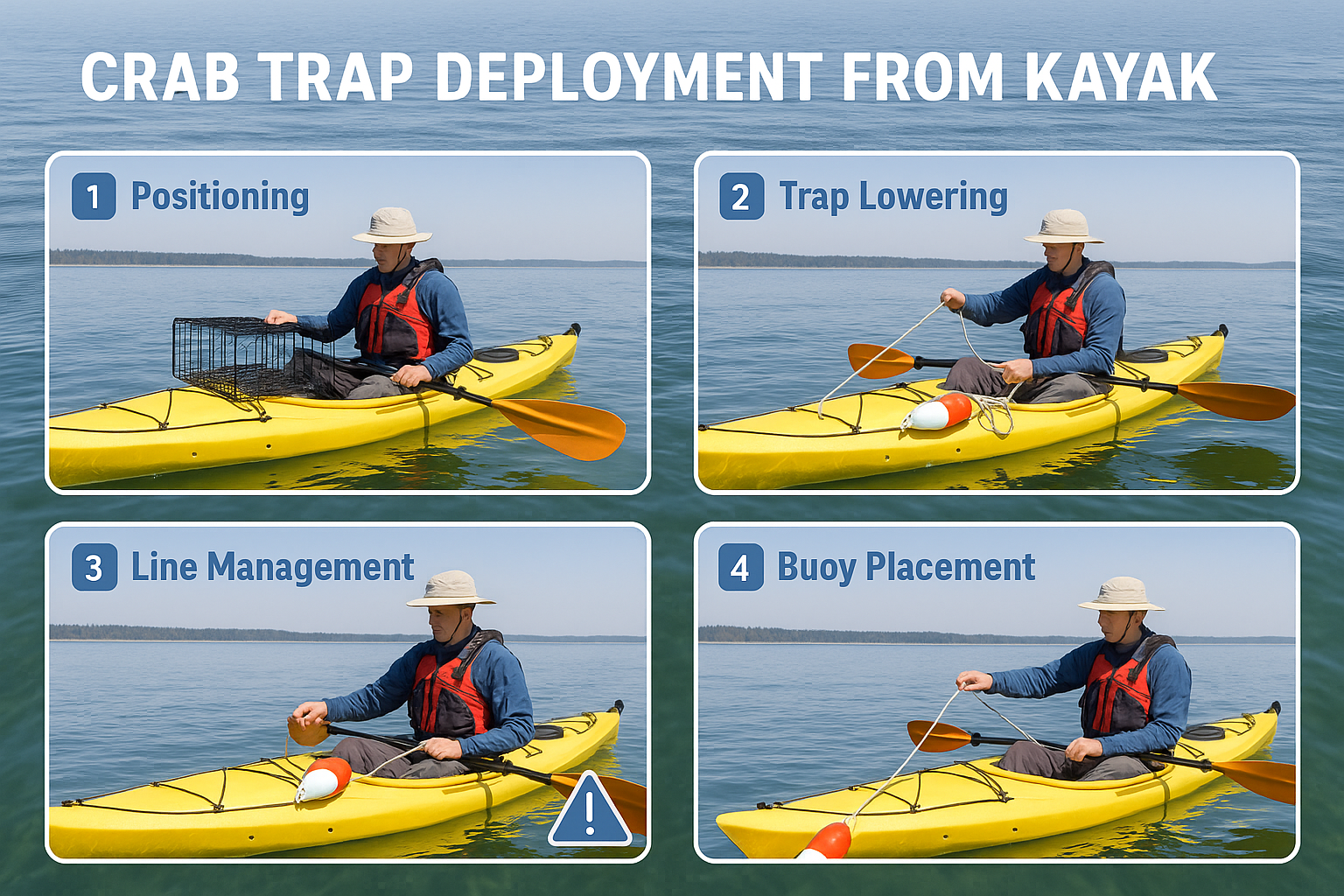
Bait Selection and Preparation: What Crabs Really Want
Fresh fish baits dominate successful crab fishing strategies. Crabs will love fresh fish like mackerel or cod. Oily fish, in particular, seem to attract them most effectively due to their strong scent dispersion in water. Sardines, herring, and salmon heads create powerful scent trails that draw crabs from considerable distances.
The oil content in fish baits serves multiple purposes beyond attraction. Oily baits release scent continuously as they decompose, maintaining effectiveness for 2-4 hours per deployment. This extended attraction period allows passive trap fishing while you work other areas or simply enjoy the paddle.
Alternative baits provide cost-effective options when fresh fish isn’t available. Chicken necks and backs work exceptionally well for blue crabs, often outperforming expensive fish baits. The high fat content and strong scent make chicken an excellent backup option that stores easily and costs significantly less than fresh fish.
Frozen squid offers another reliable alternative, particularly for Dungeness crabs. The tough texture resists small fish theft while maintaining scent attraction. Cut squid into strips and secure firmly to bait holders to prevent loss during deployment.
Bait preparation techniques maximize effectiveness and prevent loss. Score fish baits with shallow cuts to increase scent release without compromising structural integrity. Secure baits with zip ties, wire, or specialized bait clips rather than relying on hooks alone—crabs are surprisingly effective at stealing loosely attached baits.
Seasonal bait effectiveness varies with crab feeding patterns and local forage availability. Spring crabs respond well to fresh fish as they emerge from winter dormancy with aggressive feeding behavior. Summer fishing often requires stronger scents to compete with abundant natural food sources, making oily fish essential.
Cost-effective bait sourcing strategies help maintain reasonable fishing budgets. Establish relationships with local fish markets for discounted fish scraps and heads. Many processors discard perfectly good crab bait that they’ll sell cheaply or give away to regular customers.
Buying bait in bulk during sales and freezing in daily portions reduces per-trip costs significantly. Vacuum-sealed portions maintain freshness for months while allowing precise bait planning for each outing.
Timing and Location: When and Where to Find Crabs
Tidal timing represents the most critical factor in crab fishing success. I do better on an incoming tide because rising water triggers feeding behavior as crabs move up from deeper refuges to hunt in shallow areas. The two hours before and after tide changes produce the most consistent action across all species and regions.
Understanding tidal coefficients enhances timing precision. Moderate tides (4-6 foot ranges) often outproduce extreme tides because they create steady current flow without excessive turbulence. Extreme low tides expose feeding areas, while extreme highs may scatter crabs across vast flats.
Seasonal patterns follow predictable cycles tied to water temperature and reproductive behavior. Early season crabs concentrate in deeper water, gradually moving shallow as temperatures rise. Peak summer fishing occurs in 15-25 feet of water, while fall cooling drives crabs back to deeper refuges.
Molting cycles significantly impact catch rates and should influence timing decisions. Recently molted crabs avoid feeding until their shells harden, creating temporary dead periods in otherwise productive areas. These cycles occur every 4-6 weeks during active season, lasting 7-10 days per cycle.
Habitat selection requires understanding crab feeding preferences and movement patterns. Placing pots along a drop-off where crabs migrate between deep and shallow water intercepts natural movement corridors. These edge areas concentrate crabs during tidal changes and produce more consistent catches than random bottom placement.
Structure fishing targets specific bottom features that attract crabs. Rocky areas provide hunting grounds for small fish and invertebrates, while sandy patches offer digging opportunities for buried prey. The transition zones between different bottom types often hold the highest crab concentrations.
Water depth considerations balance accessibility with productivity. Most kayak crabbers work 8-30 foot depths, with the 15-25 foot range providing optimal results. Deeper water requires longer lines and more challenging trap management, while shallow water may not hold crabs consistently.
Weather and current factors influence both safety and success. Light to moderate currents help disperse bait scent while keeping traps fishing effectively. Strong currents make trap management difficult and may relocate gear significantly between checks.

Wind direction affects scent dispersion and kayak handling. Cross-shore winds create challenging conditions for trap deployment, while offshore winds may carry scent away from productive areas. Plan fishing days around favorable weather windows for maximum safety and effectiveness.
Kayak Crab Fishing Techniques: From Setup to Harvest
Trap deployment strategies from kayaks require modified techniques for safety and efficiency. Position your kayak perpendicular to current flow when deploying gear, allowing natural drift to separate you from the trap as it sinks. This prevents line entanglement with your paddle or kayak while ensuring proper trap placement.
Method selection depends on target species and personal preference. Active fishing with a hoop-style net provides immediate feedback and allows rapid area coverage, while passive traps that you can leave and return to every hour enable multiple location fishing with less physical effort.
For efficient checking patterns, establish systematic routes that minimize paddling while maximizing trap productivity. GPS marking helps maintain consistent trap spacing and prevents overlap between productive areas. Quality fish finders can mark both trap locations and productive bottom structure for future reference.
Multiple trap management from a kayak requires careful organization and timing. Deploy traps in order of intended checking, marking each location clearly on GPS or written notes. Maintain 100-200 yard spacing between traps to prevent line tangles and ensure adequate territory coverage.
Timing between checks varies by species and conditions. Active hoop nets require checking every 10-15 minutes for optimal results, while passive traps can fish effectively for 1-2 hours. Longer soak times may result in crab escape or bait loss to fish.
Crab handling techniques ensure safety and legal compliance. Approach crabs from behind to avoid powerful claws, grasping firmly across the back carapace. Measure immediately upon capture using proper gauges, and release sublegal crabs gently to minimize stress and injury.
Live well and storage considerations maintain crab quality from capture to consumption. Ventilated containers with seawater keep crabs alive and fresh, while insulated storage prevents temperature stress. Avoid overcrowding storage containers—stressed crabs fight and may injure each other.
Deployment depth management requires understanding how line length affects trap positioning. Too little line prevents proper trap settling, while excessive line creates handling difficulties and potential tangles. Calculate line length as 1.5 times water depth plus 10 feet for safety margin.
Safety and Regulations: Legal Crabbing from Your Kayak
Licensing requirements vary significantly between states and may include multiple permits. Most Pacific Coast states require a Department of Fish & Wildlife shellfish license in addition to basic fishing licenses. Atlantic Coast states often combine crab fishing under general saltwater licenses but may require additional endorsements for certain areas or methods.
Trap marking regulations mandate specific buoy colors, sizes, and identification requirements. Many states require name and license number on all buoys, while some specify buoy colors to distinguish between recreational and commercial gear. Failure to properly mark traps can result in gear confiscation and significant fines.
Safety protocols for kayak crabbing extend beyond standard paddling safety. Always be aware of your surroundings including other vessel traffic, weather conditions, and trap line locations. Carry proper communication devices and file float plans with reliable contacts before departing.
Trap line safety prevents entanglement injuries and equipment loss. Never wrap trap lines around your body or kayak, and maintain sharp knives for emergency line cutting. Practice trap deployment and retrieval in calm conditions before attempting challenging environments.
Navigation safety becomes critical when managing multiple traps across wide areas. Maintain visual references to shore and use GPS devices to track both your position and trap locations. Poor visibility conditions can make trap recovery impossible without electronic navigation aids.
Weather assessment should include both current conditions and forecasted changes. Crab fishing often requires several hours on the water, during which conditions may deteriorate significantly. Monitor marine weather forecasts and maintain conservative safety margins.
Emergency procedures specific to crab fishing include entanglement protocols and gear loss procedures. Practice self-rescue techniques and carry backup communication devices. Inform others of your planned fishing areas and expected return times.
Harvest regulations encompass size limits, bag limits, sex restrictions, and seasonal closures. These regulations change frequently and vary by specific fishing areas. Carry current regulation guides and measure all crabs carefully—violations carry serious penalties including equipment forfeiture.
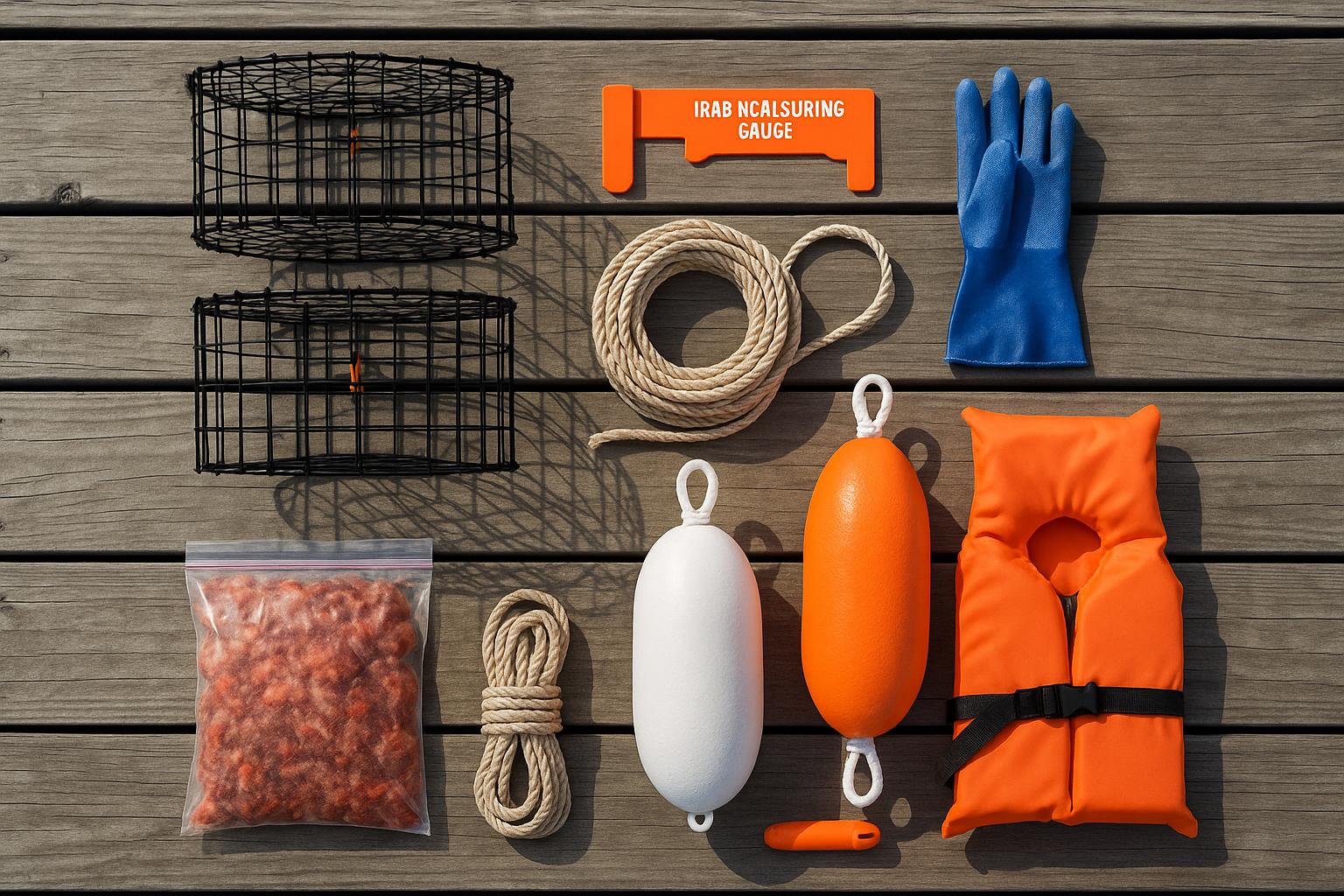
For those considering electric fishing kayaks, check local regulations as some areas restrict motorized vessels in certain zones or seasons.
Advanced Kayak Crabbing Strategies: Pro Tips for Better Success
Multi-species targeting in mixed waters requires understanding overlapping habitats and seasonal timing. Areas where Dungeness and red rock crabs coexist offer opportunities to fill mixed bags, while East Coast waters may hold both blue crabs and rock crabs simultaneously. Adjust gear and bait selection to target the most abundant or desirable species.
Electronic aids transform kayak crabbing from guesswork to precision fishing. GPS fish finders mark productive bottom structure, track trap locations, and monitor water temperature changes that affect crab behavior. Side-imaging sonar reveals bottom composition and structure that attracts feeding crabs.
Seasonal migration pattern exploitation requires understanding how crabs move between deep and shallow water throughout the year. Early season fishing targets migration corridors as crabs move shallow, while late season success comes from intercepting the reverse migration to deeper water.
Temperature monitoring helps predict crab activity levels and optimal fishing times. Digital thermometers or fish finder temperature readings guide decisions about when and where to fish. Rapid temperature changes often trigger feeding activity and improved catch rates.
Bait presentation innovations can dramatically improve success rates. Experiment with bait placement within traps, using multiple bait types simultaneously, or adding scent enhancers to standard baits. Fresh versus aged baits may produce different results depending on conditions and crab species.
Current utilization helps disperse scent more effectively and positions traps in natural feeding lanes. Deploy traps up-current from structure or drop-offs, allowing scent trails to attract crabs from maximum distances. Understanding local current patterns reveals the most productive trap placement strategies.
Efficiency maximization for limited kayak space involves careful gear selection and organization. Collapsible traps, compact storage systems, and multi-purpose equipment allow more fishing gear in limited space. Pre-rigged trap lines and organized bait storage reduce on-water preparation time.
Pattern recognition develops through consistent record-keeping and observation. Track successful fishing times, locations, weather conditions, and bait choices to identify patterns that predict good fishing. This data becomes invaluable for planning future trips and adapting to changing conditions.
Processing Your Catch: From Kayak to Kitchen
On-water processing decisions impact crab quality and storage efficiency. Live crabs maintain peak quality but require proper storage and handling. Immediate processing saves storage space and weight but requires proper cleaning techniques and ice management.
Transportation considerations vary with distance and time between capture and consumption. Live crabs need ventilation, moisture, and temperature control during transport. Processed crabs require immediate icing and careful handling to prevent spoilage.
Keeping crabs alive during extended fishing trips requires understanding their basic needs. Adequate ventilation prevents carbon dioxide buildup, while maintaining moisture prevents dehydration. Avoid freshwater contact and extreme temperature changes that stress or kill crabs.
Cleaning and cooking preparation begins with proper stunning and cleaning techniques. Quick dispatch minimizes stress and maintains meat quality. Remove gills, intestines, and other inedible parts immediately after processing to prevent off-flavors and spoilage.
Yield optimization maximizes meat recovery from each crab. Learn proper breaking and picking techniques that extract maximum meat with minimal waste. Different crab species require different processing approaches for optimal results.
Storage methods preserve quality from capture to consumption. Live crabs store best in ventilated containers with damp newspaper or seaweed. Processed crab meat requires immediate refrigeration and consumption within 2-3 days for peak quality.
Recipe suggestions help maximize enjoyment of your harvest. Simple preparations like steaming or boiling preserve natural flavors, while more complex dishes like crab cakes or bisques utilize smaller pieces and less perfect meat effectively.
Waste reduction practices include using shells for stock, composting organic waste, and sharing excess catch with friends and family. Responsible harvesting means utilizing your catch completely and avoiding waste.
Common Mistakes and Solutions: Avoiding Crabbing Failures
Poor trap placement represents the most common cause of crabbing failure. Random bottom placement rarely produces consistent results. Study bottom structure, current patterns, and crab behavior to position traps in natural feeding areas and migration corridors.
Timing errors cost many crabbers productive fishing opportunities. Ignoring tidal timing, fishing during extreme weather, or missing seasonal patterns reduces success significantly. Plan fishing trips around optimal tidal windows and seasonal crab behavior patterns.
Inadequate bait preparation results in poor scent dispersion and early bait loss. Improperly secured baits disappear quickly, while stale or inappropriate baits fail to attract crabs effectively. Invest time in proper bait selection and preparation for consistent results.
Regulatory violations carry serious consequences including fines, equipment forfeiture, and fishing privilege suspension. Ignorance of regulations isn’t accepted as an excuse—carry current regulation guides and measure all crabs carefully before keeping them.
Safety oversights create dangerous situations that can quickly become life-threatening. Inadequate safety equipment, poor weather assessment, or failure to inform others of fishing plans increases risk significantly. Maintain conservative safety margins and proper emergency equipment.
Equipment failures often result from inadequate maintenance or inappropriate gear selection. Inspect trap lines regularly for wear and damage, maintain sharp knives for emergency cutting, and carry backup equipment for critical items.
Overconfidence leads to poor decision-making and increased risk. Successful crabbing requires consistent attention to safety, regulations, and changing conditions. Maintain respect for the marine environment and your own limitations regardless of experience level.
Backup planning prevents complete trip failures when primary plans don’t work. Have alternative fishing areas, backup gear, and contingency plans for changing weather or poor crab activity. Flexibility often separates successful crabbers from frustrated ones.
The Hobie Pro Angler 12 360XR and Bonafide PWR129 represent excellent platforms for serious crab fishing, offering the stability and storage needed for extended trips.
Frequently Asked Questions
Crabbing Trip Timeline
Dungeness vs Blue Crab Comparison
| Feature | Dungeness Crab | Blue Crab |
|---|---|---|
| Preferred Habitat | Sandy/muddy bottoms, 20-100 feet deep | Shallow bays, grass beds, 3-20 feet deep |
| Best Bait | Fresh fish (salmon, herring), squid | Chicken necks, fish scraps, razor clams |
| Peak Season | December – August (varies by region) | April – November |
| Trap Type | Ring nets, crab pots | Collapsible traps, trotlines |
| Size Limit | 6.25″ carapace width (typical) | 5″ point-to-point (typical) |
| Kayak Advantage | Access to protected coves | Navigate shallow grass beds |
| Challenge | Deeper water deployment | Fast current areas |
| Soak Time | 30-60 minutes | 15-30 minutes |
Conclusion
Kayak crab fishing offers unparalleled access to productive waters while providing the stealth advantage that consistently outproduces traditional boat crabbing. The combination of shallow water access, reduced costs, and enhanced mobility creates opportunities that most crabbers never experience. Success comes from understanding species-specific techniques, proper timing, and safety protocols rather than expensive gear or secret locations.
Your path to crab fishing success begins with mastering the basics—proper gear selection, bait preparation, and trap deployment techniques. Focus on one target species initially, whether Dungeness or blue crabs, and develop expertise before expanding to multi-species strategies. The fundamental skills transfer between species, but the nuances matter significantly.
Seasonal preparation should include gear maintenance, regulation updates, and physical conditioning for the demands of kayak crabbing. Pre-season gear checks prevent on-water failures, while staying current with regulation changes avoids costly violations. Physical preparation enhances safety and enjoyment during long days on the water.
Progressive skill development transforms novice crabbers into consistently successful harvesters. Start with simple setups in protected waters, gradually expanding to more challenging conditions and advanced techniques. Each trip provides learning opportunities that build toward mastery of this rewarding fishing method.
Community resources accelerate learning through shared knowledge and experience. Local kayak fishing clubs, online forums, and experienced mentors provide insights that books and articles cannot match. Contributing to these communities through trip reports and technique sharing helps everyone improve.
Ethical harvesting practices ensure sustainable crab populations for future generations. Follow all regulations strictly, release sublegal crabs carefully, and avoid overharvesting even when limits allow it. Practice selective harvesting that maintains breeding populations while providing excellent table fare.
The stealth, access, and cost advantages of kayak crab fishing create opportunities for consistent success that traditional methods simply cannot match. Whether you're targeting Pacific Dungeness or Atlantic blue crabs, the principles remain consistent—understand your target species, fish at optimal times, and prioritize safety above all else. Your next limit of fresh crabs awaits just a paddle stroke away from the crowded boat launch.

